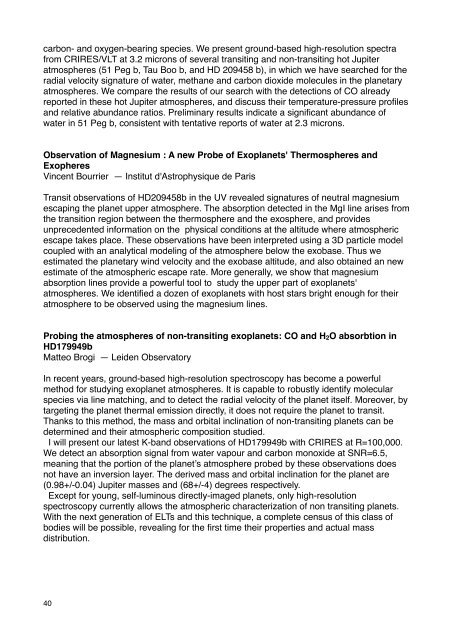Exoclimes_Conference_booklet1
Exoclimes_Conference_booklet1
Exoclimes_Conference_booklet1
You also want an ePaper? Increase the reach of your titles
YUMPU automatically turns print PDFs into web optimized ePapers that Google loves.
carbon- and oxygen-bearing species. We present ground-based high-resolution spectra<br />
from CRIRES/VLT at 3.2 microns of several transiting and non-transiting hot Jupiter<br />
atmospheres (51 Peg b, Tau Boo b, and HD 209458 b), in which we have searched for the<br />
radial velocity signature of water, methane and carbon dioxide molecules in the planetary<br />
atmospheres. We compare the results of our search with the detections of CO already<br />
reported in these hot Jupiter atmospheres, and discuss their temperature-pressure profiles<br />
and relative abundance ratios. Preliminary results indicate a significant abundance of<br />
water in 51 Peg b, consistent with tentative reports of water at 2.3 microns.<br />
Observation of Magnesium : A new Probe of Exoplanets' Thermospheres and<br />
Exopheres!<br />
Vincent Bourrier — Institut d'Astrophysique de Paris<br />
Transit observations of HD209458b in the UV revealed signatures of neutral magnesium<br />
escaping the planet upper atmosphere. The absorption detected in the MgI line arises from<br />
the transition region between the thermosphere and the exosphere, and provides<br />
unprecedented information on the physical conditions at the altitude where atmospheric<br />
escape takes place. These observations have been interpreted using a 3D particle model<br />
coupled with an analytical modeling of the atmosphere below the exobase. Thus we<br />
estimated the planetary wind velocity and the exobase altitude, and also obtained an new<br />
estimate of the atmospheric escape rate. More generally, we show that magnesium<br />
absorption lines provide a powerful tool to study the upper part of exoplanets'<br />
atmospheres. We identified a dozen of exoplanets with host stars bright enough for their<br />
atmosphere to be observed using the magnesium lines.<br />
Probing the atmospheres of non-transiting exoplanets: CO and H2O absorbtion in<br />
HD179949b!<br />
Matteo Brogi! — Leiden Observatory<br />
In recent years, ground-based high-resolution spectroscopy has become a powerful<br />
method for studying exoplanet atmospheres. It is capable to robustly identify molecular<br />
species via line matching, and to detect the radial velocity of the planet itself. Moreover, by<br />
targeting the planet thermal emission directly, it does not require the planet to transit.<br />
Thanks to this method, the mass and orbital inclination of non-transiting planets can be<br />
determined and their atmospheric composition studied.<br />
I will present our latest K-band observations of HD179949b with CRIRES at R=100,000.<br />
We detect an absorption signal from water vapour and carbon monoxide at SNR=6.5,<br />
meaning that the portion of the planet’s atmosphere probed by these observations does<br />
not have an inversion layer. The derived mass and orbital inclination for the planet are<br />
(0.98+/-0.04) Jupiter masses and (68+/-4) degrees respectively.<br />
Except for young, self-luminous directly-imaged planets, only high-resolution<br />
spectroscopy currently allows the atmospheric characterization of non transiting planets.<br />
With the next generation of ELTs and this technique, a complete census of this class of<br />
bodies will be possible, revealing for the first time their properties and actual mass<br />
distribution.<br />
40


